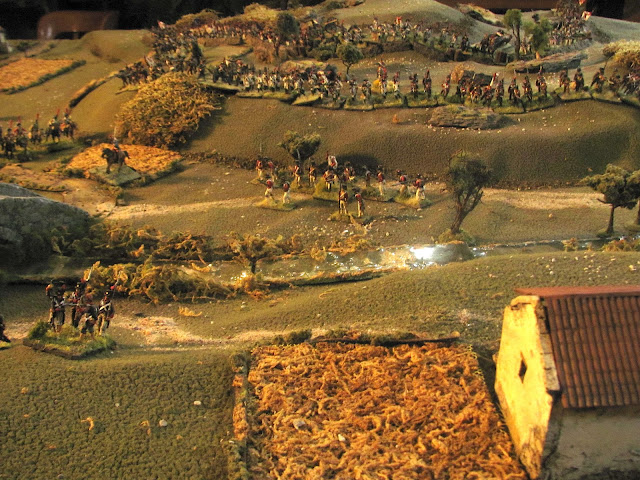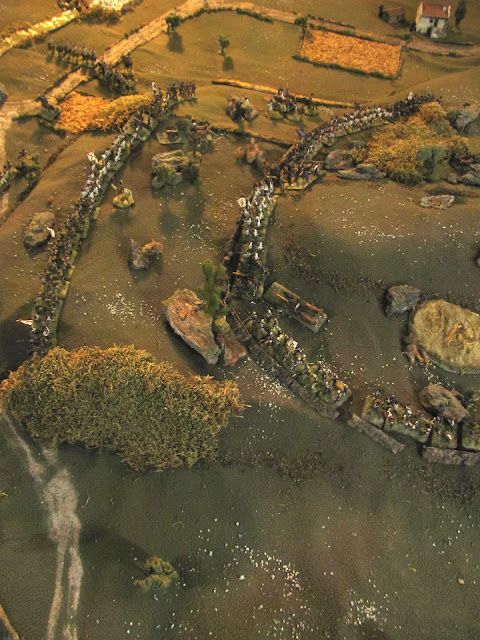I haven’t written up a battle report for ages, or indeed posted at all on this blog, but have been really enjoying our foray into the Lardies’ Chain of Command rules. The other day I decided to game solo, with the intention of fielding my newly minted British paras against a German platoon of green conscripts. I was curious about two things. The first was how the paras would fare, as at first glance they seem to field a lot less than the standard British platoon for a greater cost. But I had noticed the superior junior leader rule, which really adds to the command and control aspect, paying off on my first deployment roll that featured three fours!
I also noted the addition of the sniper and some of the airborne specific options, like upgrading a rifle section to be two Bren guns. I took the last option, and then spent their remaining points (rolled low) on a 2” mortar, a 6 pdr. and crew and a PIAT team as insurance. As it turned out the PIAT was never fielded but both the mortar and especially the 6 pdr. earned their keep.
The green Germans meant that they actually received more support points than the attackers, which they spent on what is always my first choice, an additional senior leader, plus a Marder II and a Stummel, giving me an odd little Kampfgruppe which seemed to work for a hastily thrown together delaying action - the scenario I was playing. The Germans also rolled a spectacular morale roll (feeling cocky) which gave them 11 morale to the British 8.
So on to the battle…
As we are still learning the game and playing fictional scenarios, we have been constructing our boards randomly, dicing for the elements on a grid basis. The rolls generated lots of terrain this time, three hills, some large areas of tall crops, and a huge area of soft ground on the British right (this view is from the British end of the table).
It also generated a good defensive positions for the Germans, with a low stone wall running across most of their deployment area (top of board) backed by a couple of hills that provided some rear area cover.
Out of the frame, on the left, is a small copse of trees, really the only cover available to the British on that flank.
The key jump off point used for the para attack.
This German JOP is the objective. Holding this at game end wins.
The Germans, getting the initiative, begin by deploying a section on their far right behind a stone wall bordering a track.
At the same time they opt to get their armour support on the field, a Marder II and Sdkfz. 251/9 Stummel, as these need to get well forward to be beyond the hills and have an open field of fire.
An overview of the German line, with one section deployed on the right and the armour top left. The objective is behind the stone wall at the top.

7. Airborne Bren section deployed
The British deploy their Bren section on the left, the British lieutenant deploying with them as does the 2” mortar a bit further back, to provide fire support for the main attack on the right.

8. Airborne rifle section deployed
At the same time the first rifle section deploys, scrambling to get over the hill and into the cover of the large field beyond.
Bren section is in the copse at the bottom, the lieutenant just behind and the 2” mortar at bottom right, which immediately goes into action. The rifle section is on the hill at top right.
The paras are immediately in trouble as the Germans deploy a second section in front of the objective JOP who, along with the Marder II and Stummel, deliver devastating fire.

11. Third German section deployed
The third and final German section is deployed on the right, bringing 26 FP die to bear on the British Bren section in the copse.

12. Bren section at losing end of fire fight, withdraw to cover
With their lieutenant wounded and then stunned the Bren section, at the losing end of this vicious firefight, is forced to fall back behind the copse to regroup.
The Germans are now fully deployed behind the stone walls. The British 2” mortar has dropped some smoke, trying to give their already beleaguered attack a bit of respite while the Bren section, bottom left, prepares to pull back.

14. Battered rifle section makes it to cover
The para rifle section makes it off the hill and disappears into tall crops but have left half their section behind as casualties on the hill. They desperately need some support…

15. 6 pdr. goes into action...
Which arrives in the shape of the 6 pdr. (Obviously not a 6 pdr.🙄 For some reason I got it in my head the Airborne Pack Howitzer was their version of the 6 pdr. ) The first shot clips the Stummel (which I'm not taking back!)
And the second seriously rattles the Marder II which has pulled beyond the smoke to get a shot in. A double phase allows a third shot that blows the Stummel sky high! This is followed up with a fourth shot on the next British phase that dispatches the Marder and suddenly things are looking much better for the British.

17. Final airborne section deployed
The British use this opportunity to get their third section into play, albeit a bit more cautiously this time, using the hill as cover before sprinting to the fields. The 6 pdr. although still in action, has been clobbered by the full weight of the German small arms fire as the gun has become the only visible target.

18. Germans now take heavy fire
The tables are now reversed. As the Germans move to reposition from their right flank to protect the Objective JOP, they take heavy fire from the mortar and Bren section, back in action. A German section leader is killed and the green troops are rendered ineffective by mounting shocks. Also the loss of the two AFV’s have reduced the German morale to 5 and they are now operating with one less command die.
With time running out for the British (the Germans have hoarded their CoC points and now spend 9 to end the second turn and initiate Final Countdown) the British press home their attack. Under heavy fire and mounting casualties the two rifle sections press forward into small arms short range centre right with the platoon sergeant taking a couple of bullets but pressing on. The 6 pdr, bottom right, still pinned at turn end, is out of the fight. Both sides are now down to one morale point apiece so not many command dice in play…
 20. British press home the attack
20. British press home the attack
The ticking clock rounds end and a double six will give the game to the Germans. The British, on their phase and with a single section leader activation die available, debate whether to hazard a close combat to seize the Objective JOP (a gamble that might come up short of contact, although they have the numbers and both German leaders here are hors de combat) or fire a volley. They opt for the latter, score a wound on the German sergeant and the enemy morale drops to 0. Game end.
I am fascinated by the way CoC games come to an end - such interesting game mechanics. Usually, with reduced command dice, the play switches rapidly from side to side and becomes super focussed. Peripheral troops become irrelevant as all the action zeroes in on the key point of the battlefield, creating a terrific narrative tension. In our half dozen games so far I think they all have ended through morale loss, even though every attempt is made to seize the objectives and we are often a phase or two away from that probably happening.
So Airborne vs. German green infantry? I would say the airborne superior junior leader really gave a lot of command options to the British, and the extra 2 FP die for 1 support point seemed value for the upgrading to a Bren section. The sniper only took two shots, both misses, and the PIAT was never deployed. This was probably my fault, having chosen two of the three units (sniper, mortar and PIAT) that all activate on 1’s, rolls which just didn’t show up for most of the game.
I love the 6 pdr. - it was my favourite weapon when I played Battlefront WWII and it has paid off in spades twice now in CoC games. And I can’t field the British without them having their the ubiquitous British 2” mortar, which again totally out performed and, being adjacent to its JOP, managed to replenish successfully although too late to fire again.
German green troops? Honestly, with the extra senior commander, they were rarely debilitated by the increased shock effects and their good morale roll padded them from the decreased command dice later in the game. So I would say I got value for money, gaining those 5 support points. However those were spent badly on the two lightly armoured AFV’s - next time I will be fielding AT and infantry guns, I think! Armour has not performed well in our games, which suits me fine as I prefer infantry battles anyway!








































